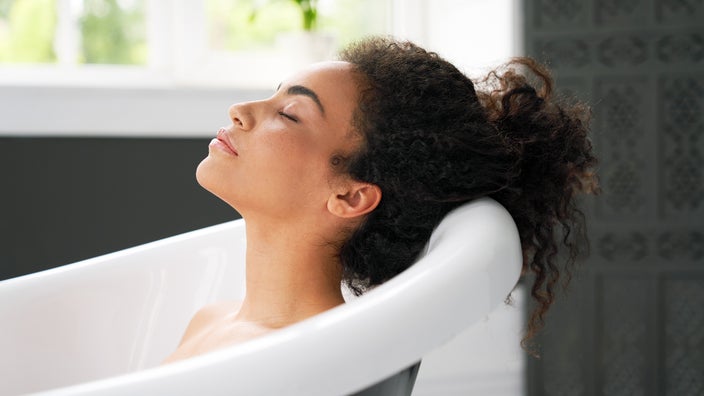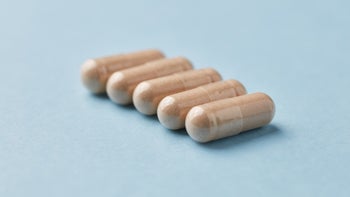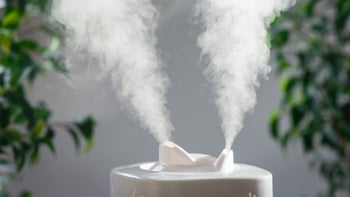
5 Proven Benefits of Hot Baths
Key takeaways:
Hot baths are a form of hydrotherapy, a treatment that uses water to address different health conditions.
Research shows that hot baths may provide both mental and physical health benefits.
Hot baths are generally safe. But some people should avoid them. It’s best to talk to a healthcare professional first.
Table of contents

Many people enjoy winding down with a hot bath at the end of a long day. It’s a great way to slow down and relax, especially in colder weather. But there may be more benefits to a hot soak than most people realize.
Hot baths are a form of both hydrotherapy and passive body heating. They have been studied as a complementary treatment for conditions like low mood, poor sleep, and sore muscles. Keep reading to learn all about the hot bath benefits and when a cooler bath may be a better option.
What are the benefits of hot baths?
For centuries, people around the globe have explored the advantages of hydrotherapy. Water has been used in various forms to ease a variety of health conditions. Hydrotherapy includes treatments like saunas, cold water immersion, and hot baths.
Search and compare options
In most studies, a hot bath has a water temperature between 104°F and 108.5°F (40°C to 45.2°C). This is hotter than the water you normally use at home. But a warm bath at any temperature is still likely to provide the following five health benefits.
1. Soothe sore muscles
Hot baths are a form of full-body heat therapy. And heat therapy can be an effective way to treat sore muscles. The heat increases blood flow to your muscles, aiding in recovery. Better blood flow also helps relax tight muscles, which may ease soreness.
2. Improve rheumatoid arthritis and joint pain
In addition to helping muscles, hot baths may benefit people with conditions that lead to pain and restricted range of motion in their joints.
People with rheumatoid arthritis (RA) see improvements in joint pain and stiffness after a warm bath. It’s thought that the warm water helps loosen inflammatory cells in the synovial fluid (the protective fluid between joints). This allows the joints to move more comfortably.
The buoyancy of the water also decreases pressure on joints, providing relief for those experiencing pain and stiffness from RA.
People with fibromyalgia may also see improved symptoms from baths. Research suggests that spa therapy methods, like warm whirlpool baths, can reduce pain and improve quality of life for people with this condition.
3. Lower blood pressure and support heart health
Research suggests that hot baths may help people temporarily lower their blood pressure. Maintaining your blood pressure in a healthy range is key to heart health.
One study showed that hot water baths in the evening led to lower blood pressure the following morning. Another study found a link between regular baths and a lower rate of coronary artery disease. This is the heart condition that can lead to heart attacks.
Are ice baths good for you? Ice baths can help relieve muscle aches and may even boost your mood. But they come with some risks you should know about before you plunge.
Hot vs. cold showers postworkout: Both hot and cold showers have benefits. Learn when to choose one over the other.
What’s the best postworkout drink? Proper hydration after a workout can help speed recovery and boost exercise performance. The best drink for you will depend on your fitness goals.
Just keep in mind that hot baths shouldn’t replace healthy lifestyle changes or traditional treatment methods for high blood pressure or other heart conditions.
4. Help relieve stress and fight depression
Many people use a hot bath for stress relief. And research supports this relaxing ritual as a way to soak away the day’s worries and boost your mood.
Compared to warm showers, warm baths may reduce:
Tension
Anger
Anxiety
Depression
Read more like this
Explore these related articles, suggested for readers like you.
One study looked at the effects of hot baths on people with depression. It found that participants who took 2 baths a week felt less depressed after 4 weeks.
5. Help you get a better night’s sleep
If you have trouble sleeping, try taking a hot bath before bed. Studies have found that bathing in hot water for at least 10 minutes can improve sleep quality.
Are hot tubs a good alternative to baths?
Hot tubs are another form of hydrotherapy. Traditionally, hot tubs are above ground, outdoors, and seat multiple people, allowing you to make your warm soaks a social activity. While the water temperature of hot tubs and regular hot baths can be similar, hot tubs:
Are maintained with chemical balancing and filtration
Have jets that pump in water and can provide the benefits of massage therapy, including better circulation, fewer aches and pains, and less stress
Aren’t intended for washing your body, so don’t include use of soap or suds
It’s important to make sure a hot tub is properly cleaned before you get in. Soaking in a dirty hot tub exposes you to bacteria-filled water, which can lead to:
Diarrhea (from cryptosporidiosis or other infections)
You can use test strips to ensure that hot tub water has been disinfected. Remember to follow these and other best practices for hot tub safety, including showering before you get in the water and avoiding alcohol before and during a soak.
Are there risks to taking hot baths?
Taking a hot bath at home is a safe and relaxing practice to add to your self-care routine. But there are some potential risks to know about.
Heart conditions or blood pressure issues
As mentioned above, heat and hot water can affect blood pressure. People with blood pressure or heart rate issues, or other cardiovascular conditions should monitor their symptoms when taking a bath. This includes people with:
Postural orthostatic tachycardia syndrome (POTS) or orthostatic hypotension
Heart failure
Aortic stenosis
If you have any of these conditions, avoid using very hot water or staying in the bath for too long. If you start to feel lightheaded or unwell, drain the bath and ask someone for help getting out.
Pregnancy
For those who are pregnant, a warm bath at home is generally considered a safe way to relax. But you should steer clear of hot tubs, or any other high-temperature environment that could raise your core temperature above 102.2°F during pregnancy. This could increase the risk of birth defects.
Skin conditions
Finally, hot water can dry out your skin, especially in the winter. People with skin conditions like eczema and psoriasis should avoid water temperatures that are too high. When you do have a soak, limit your time in the water.
What’s the best way to take a hot bath?
Many people enjoy the calming benefits of a bath before bed. But you can slow down for a soak whenever you like.
Finding the right water temperature depends on your preferences. You want the water to be a little hotter than your body temperature, but not so hot that it burns or feels uncomfortable. As a general rule, the higher the water temperature, the shorter the soak should be. If hot baths are new to your daily routine, consider setting a timer for 10 to 15 minutes.
You can add ingredients like oatmeal, Epsom salt, or lavender essential oil to make your bath even more relaxing. Lavender is known to have a calming effect. In one study, lavender oil reduced the levels of cortisol (a stress hormone) in mothers and newborns during the infant’s bath time.
Frequently asked questions
For most people, the best temperature for bath water is between 95°F and 105°F, just slightly higher than the average body temperature.
While a bath won’t cure the cold or flu, it may help relieve symptoms. For example, baths can provide comfort if you’re experiencing aches and chills. The steam from a hot bath can also add moisture to your nasal passages and potentially relieve a stuffy nose.
Taking a hot bath daily is a relaxing, stress-relieving ritual. As long as you don’t have health conditions that require limiting hot baths, a daily soak can benefit your health.
The bottom line
Taking a hot bath is a relaxing activity that has multiple science-backed health benefits, like reduced stress and lower blood pressure. Hot baths are safe for most people. While there’s no wrong time to take a bath, enjoying a soak before bedtime might even help ease you into a good night’s sleep. One of the best things about hot baths is they are convenient and accessible.
Why trust our experts?



References
American Pregnancy Association. (n.d.). Hot tubs during pregnancy.
Centers for Disease Control and Prevention. (2024). About cryptosporidiosis.
Centers for Disease Control and Prevention. (2024). Home pool and hot tub water treatment and testing.
Centers for Disease Control and Prevention. (2024). Preventing hot tub rash.
Centers for Disease Control and Prevention. (2024). What you can do to stay healthy in hot tubs.
Field, T., et al. (2008). Lavender bath oil reduces stress and crying and enhances sleep in very young infants. Early Human Development.
Gianfaldoni, S., et al. (2017). History of the baths and thermal medicine. Macedonian Journal of Medical Sciences.
Goto, Y., et al. (2018). Physical and mental effects of bathing: A randomized intervention study. Evidence-Based Complementary and Alternative Medicine.
Guidelli, G. M., et al. (2012). Fibromyalgia syndrome and spa therapy: Myth or reality? Clinical Medicine Insights: Arthritis and Musculoskeletal Disorders.
Haghayegh, S., et al. (2019). Before-bedtime passive body heating by warm shower or bath to improve sleep: A systematic review and meta-analysis. Sleep Medicine Reviews.
Hanusch, K., et al. (2020). The impact of whole-body hyperthermia interventions on mood and depression – are we ready for recommendations for clinical application? International Journal of Hyperthermia.
Naumann, J., et al. (2017). Effects of hyperthermic baths on depression, sleep and heart rate variability in patients with depressive disorder: A randomized clinical pilot trial. BMC Complementary and Alternative Medicine.
Ukai, T., et al. (2020). Habitual tub bathing and risks of incident coronary heart disease and stroke. Heart.
Yamasaki, S., et al. (2024). Night-time hot spring bathing is associated with a lower systolic blood pressure among japanese older adults: A single-institution retrospective cohort study. Geriatrics.





























